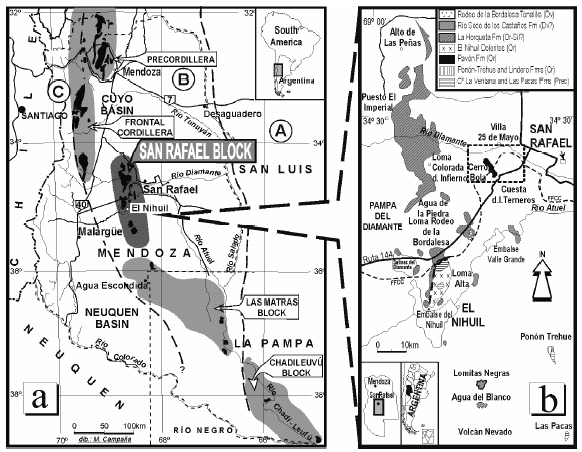
The Caradoc Siliciclastic Sequence of the Pavon Formation, San Rafael Block, Mendoza, Argentina
Carlos A. CINGOLANI
, Paulina ABRE and Marcelo MANASSEROCentro de Investigaciones Geológicas-División Geología, Universidad Nacional de La Plata, calle 1 n. 644, La
Plata, Argentina. E-mail:
ccingola@cig.museo.unlp.edu.ar
Abstract:
THE CARADOC SILICICLASTIC SEQUENCE OF THE PAVON FORMATION, SAN RAFAEL BLOCK, MENDOZA, ARGENTINA..The San Rafael Block lies in the central-western region of the Mendoza province, Argentina and was recognized as a southern extension of the Precordillera Terrane. It shows diverse igneous-metamorphic and sedimentary units from Precambrian to Middle Paleozoic age, known generally as "Pre-Carboniferous units". One of these units is the Pavón Formation, that crop out in the central portion of the San Rafael Block, at the eastern slope of the Cerro Bola and it is composed by a folded siliciclastic association of massive green-reddish-grey sandstones, wackes, quartz sandstones, siltstones and interbedded black shales. The Pavón Formation shows a rich graptolite fauna composed by 23 taxa within the black shales and siltstones. The presence of C. bicornis bicornis-tridentatus allow us to recognize the Early Caradoc age Climacograptus bicornis Biozone, for the Pavón Formation and to correlate it with equivalent Precordilleran siliciclastic units. Sandstone petrography, geochemistry of major, trace and rare earth elements, constrain the provenance and tectonic setting of deposition. The QFL provenance data, grouping in the recycled orogen and continental block, indicate that the source of detritus of the Pavón Formation has an average upper crustal composition. In view of intense recycling and diagenetic processes, diagrams involving immobile trace elements are considered a good complementary source tracers. They suggest an active margin and island continental arc provenance. REE element distributions provide evidence of upper crust source materials. In the regional context of the early evolution of the Precordillera terrane, the data suggest that the Pavón Formation was deposited in a basin generated after the accretion of the Precordillera terrane at the actual position in Gondwana, and uplift by thrusting of the Grenville-age crust to the East, as a possible source for sediments.Resumen:
LA SECUENCIA SILICICLÁSTICA DE FORMACIÓN PAVÓN, BLOQUE DE SAN RAFAEL, MENDOZA, ARGENTINA. El Bloque de San Rafael ubicado en el centro-oeste de la Provincia de Mendoza, Argentina, fue reconocido como la extensión meridional del Terrane Precordillera. En su composición geológica se destacan diversas unidades ígneometamórficas y sedimentarias del Precámbrico y Paleozoico, conocidas como "pre-Carboníferas". Una de ellas es la Formación Pavón que aflora en la parte central del Bloque de San Rafael, en el flanco oriental del Cerro Bola y está compuesta por una asociación silicoclástica de areniscas masivas verdosas-rojizas-grises, vaques, areniscas cuarzosas, limolitas e intercalaciones de pelitas negras. La Formación Pavón, en sus niveles pelíticos y limolíticos presenta una rica fauna de graptolitos compuesta por 23 taxones. La presencia de C. bicornis-tridentatus permitió reconocer a está unidad como correspondiente Caradociano inferior, Biozona de Climacograptus bicornis y asi correlacionarla con formaciones silicoclásticas equivalentes de la Precordillera. La petrografía sedimentaría, geoquímica de mayoritarios, traza y tierras raras, permite constreñir la procedencia y ambiente tectónico de depositación. En los triángulos QFL las muestras se agrupan en orógeno reciclado y bloque continental, indicando que la fuente de detritos de la Formación Pavón tuvo un promedio de composición de corteza continental. En virtud del intenso reciclaje y de procesos diagenéticos sufridos por las rocas estudiadas, los diagramas que utilizan elementos traza inmóviles son considerados como complementos muy útiles para el análisis de zonas fuente. Estos sugieren una procedencia de margen activo y arco continental. La distribución de las tierras raras proveen por su parte, evidencias de una fuente de corteza superior. En el contexto regional de la evolución del Terreno Precordillera durante el Paleozoico Inferior, los datos obtenidos sugieren que la Formación Pavón, fue depositada en una cuenca generada después de la acreción del Terreno a su actual posición en el margen del Gondwana, con el consecuente cabalgamiento de corteza de "edad Grenville" desde el Este como una fuente posible de los sedimentos.Keywords:
San Rafael Block, Mendoza, Caradoc age, C. bicornis Biozone, sandstone petrography, geochemistry, tectonic setting.Palabras clave:
Bloque de San Rafael, Mendoza, Caradociano, Biozona de C. bicornis, petrografía sedimentaria, geoquímica, ambiente tectónico.Introduction
The San Rafael Block lies in the central-western region of the Mendoza province, Argentina and was recognized as a southern extension of the Precordillera Terrane (Fig. 1a) and as a part of the Occidentalia or Cuyania composite terranes (Ramos
et al., 1986; 1998; Dalla Salda et al., 1992; Astini et al., 1995), or together with other such belts (Las Matras-Chadileuvú) constitutes the "belt with Grenvillian-age rocks" (Sato et al., 2000). For historical review and stratigraphy of the Precordillera terrane and for the evolution in the proto-Andean margin of Gondwana during the Early Paleozoic see Keller (1999), Pankhurst and Rapela (1998) and Aceñolaza et al. (2002). To the North and South the San Rafael Block is bounded by the Cuyo and Neuquen oil basins respectively and eastwards grades to the pampean plains vanishing under the Quaternary deposits. To the West, the boundary is defined by the Frontal Cordillera. The San Rafael Block shows diverse igneous-metamorphic and sedimentary units from Precambrian to Middle Paleozoic age, known generally as "Pre-Carboniferous units" (Fig. 1b) due to their clear differentiation from the Carboniferous beds by a regional unconformity (Dessanti, 1956; Nuñez, 1979; González Díaz, 1981). One of these units is the Pavón
Figure 1. a
: Location of the study area in the San Rafael Block. b: Outcrop distribution of the Pre-Carboniferous units within the San Rafael Block.Formation, that crop out in the central portion of the San Rafael Block, at the eastern slope of the Cerro Bola (68°30’W-34°35’S) and it is composed by a folded siliciclastic sedimentary sequence (Fig.2).
Stratigraphy and graptolite fauna
The Pavón Formation (Holmberg, 1948,
emmend Cuerda and Cingolani, 1998) is composed by an association of massive green-reddish-grey sandstones, wackes, quartz sandstones, siltstones and interbedded black shales. The base of the 700 m sequence is not exposed. The thickness of the sandstone strata vary from 0.40 to 1 m. The sequence is intruded by the Permo-Triassic cerro Bola rhyolitic dome and acidic dykes of about 2-3 m thick. Also thin hydrothermal quartz veins are common in the whole section. Important tectonic deformation affected sandstone grains, generation of cleaveage, elongation of graptolites and siliceous recrystallization were recognized (Fig. 3).The Pavón Formation shows a rich graptolite fauna composed by 23 taxa (Cuerda and Cingolani, 1998) within the black shales and siltstones. The recognized taxa are distributed in assemblages (Fig. 4) with stratigraphic ranges as follow:
Association I:
In the first 65 m of the stratigraphic column, in the core of the anticlinal structure, the recognized taxa are, Climacograptus bicornis, Climacograptus tridentatus, Amplexograptus aff. arctus, Lasiograptus costatus, cf. Normalograptus cf. tubuliferus and Orthoretiolites sp.Association II:
In the western side of the anticlinal, 25 m above de Association I. Predominance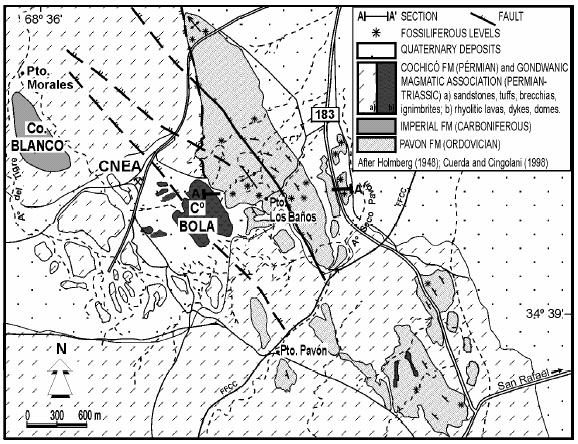
Figure 2.
The Pavón Formation outcrops, in the Eastern slope of the Cerro Bola. A-A’ Geological section shown in Fig. 3.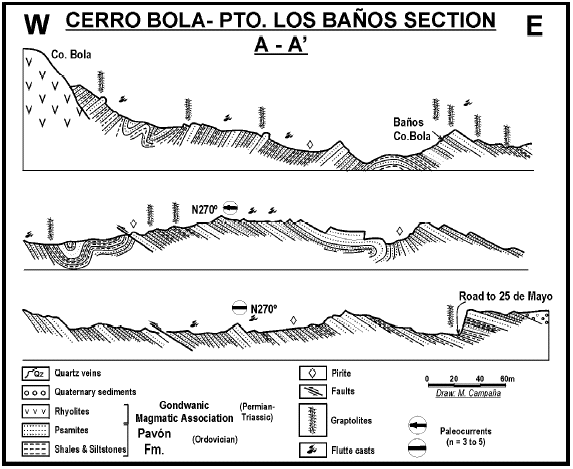
of Dicranograptids like,
Dicranograptus ramosus ramosus, Dicranograptus ramosus cf. longicaulis, Dicranograptus nicholsoni nicholsoni.Association III:
In the upper part of the sequence, 600 m above the Association II. It is distinguished by the presence of the Orthograptids, like Orthograptus truncatus aff. truncatus, Orthograptus aff. apiculatus; Dicellograptids like Dicellograptus salopiensis, Dicellograptus forchammeri cf. flexuosus, associated with Pseudoclimacograptus scharenbergi, Glossograptus aff. ciliatus, Cryptograpus tricornis insectiformis, Leptograptus validus validus, Normalograptus cf. tubuliferus, Climacograptus cf. caudatus, Lasiograptus costatus, Climacograptus bicornis, Climacograptus tridentatus, Orthoretiograptus sp., Hallograptus sp., Glyptograptus sp.The presence of
C. bicornis bicornis-tridentatus en Associations I and III allow us to recognize the early Caradoc age Climacograptus bicornis Biozone, for the Pavón Formation and to correlate it with equivalent Precordilleran siliciclastic units (Fig. 5).Sedimentological and petrographical aspects
The Pavón Formation is a sand dominated facies, with regular tabular bedding with sharp contacts, scarce flow and load casts at the base of the beds and uncommon channels and syndepositional deformation structures (Cingolani
et al., 1999). A simplified sedimentary model of a non-fan sandy marine turbidite was suggested by Manassero et al. (1999) showing the relativeFigure 3.
Geological section at Puesto Los Baños (A-A’ in Fig. 2).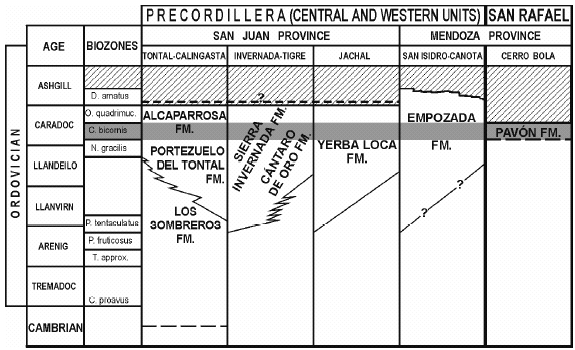
position of all the studied sections along a constructional continental slope, and the progradational system of the Pavón Formation produced important vertical (rather than lateral) facial changes suggesting that the rocks were deposited within a linear through. The lithofacies of the Pavón Formation fit well under the sedimentary deposits known as concentrated density flows, characterized by sand dominated facies, with sharp contacts and plastic rheology. This model give important differences between turbidity currents and debris flows in terms of mechanisms and deposits and sedimentary features, though, they reflect the mechanism of deposition and not necessarily the mechanism of transport.
The textural data on sandstone petrography samples show 15 to 30% matrix content, poor to moderate sorting and medium to very fine grain sizes. The illite crystallinity values measured by XRay Diffraction in shales have been obtained using international standards CIS (Manassero
et al., 1999) and suggest anchimetamorphic grade conditions. Petrographic analyses of sedimentary rocks has been proved very useful for determining provenance (Dickinson and Suczek, 1979; Dickinson et al., 1983). In matrix rich rocks provenance resolution by microscope methods, can be enhanced by the geochemistry of minor and trace elements considering than only the more stable minerals are preserved from weathering and diagenesis. Minerals recorded are quartz (monocrystalline and polycrystalline), K-feldpars, plagioclase, biotite, muscovite, chlorite, opaques, tourmaline, zircon, apatite, hematite and sedimentary and metamorphic rocks fragments (Cingolani et al., 1999). In the QFL ternary diagrams the samples plotted in a recycled orogen and continental block provenance fields. Much of the scatter in the data results from differences in the population of quartz and feldspars grains. Although they show dispertion, we could assume an uplifted continental fragment as a source area. Similar data was obtained by Loske (1992) for Precordilleran Ordovician units.Paleocurrent data suggest that a positive land was located to the east of the region with Pavón Formation outcrops.
Figure 4.
Graptolites assemblages for the Pavón Formation (after Cuerda and Cingolani, 1998).Geochemistry: provenance and tectonic setting
The geochemistry of more than twenty Pavón Formation samples (Cingolani et al., 2002) for major, trace and rare elements was obtained by ICP, ICP/MS methods. Trace elements and REE are most suitable than major elements for determination of provenance, tectonic setting and tracing crustal evolution (e.g. Taylor and McLennan, 1985; Bhatia and Crook, 1986; McLennan, 1989; McLennan et al., 1991; Balhburg, 1998; Bock
et al., 2000; Zimmermann et al., 2000) because of their relatively low mobility during sedimentary processes. These elements are generally thought to be thoroughly transported into clastic sedimentary rocks after weathering, and thus they may reflect the signature of parent materials.The chondrite-normalized REE spectra have a moderate enrichment of LREE relative to HREE, a pronounced negative Eu anomaly and a relatively flat HREE distribution. The comparison of this pattern with the Post Archean Australian Shale composite (Taylor and McLennan, 1985) shows the similarity of the Pavón Formation samples with the average upper crustal composition. In the scheme proposed by Winchester and Floyd (1977), based on Zr/TiO
2 and Nb/Y ratios for bulk geochemistry, most of the Pavón Formation samples show a rhyodacitic composition. Nb/Y ratio is an indicator of alkalinity and varies between 0.26 and 0.76, while Zr/TiO2 is a measure of the degree of differentiation and varies between 0.03 and 0.10. This is coherent with a derivation from acid to intermediate igneous precursor as dominant sedimentary source (Cingolani et al., 2002). The Pavón Formation samples have Th/Sc average ratio of 0.78, consistent with an upper crustal derivation. The Pavón Formation have a high values of Zr/Sc ratio, that is indicative of significant reworking (zircon abundance). In the La/Th vs. Hf diagram after Floyd and Leveridge (1987) all the Pavón Formation samples fall in between acid arc source to increasing old sediment component, with La/Th ratios similar to upper continental crust (Fig. 6a). In the Ti/Zr vs. La/Sc diagram (Fig. 6b) most of the studied samples plot in the fields of active continental margin and continental island arc derivation.Sedimentary sorting and heavy minerals
The chemical composition of sedimentary rocks is also influenced by hydraulic sorting. Considering the reworking and selective sorting during transportation resistant heavy minerals like zircon are
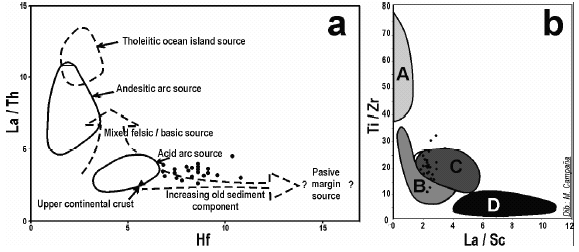
Figure 6, a:
La (ppm)/Th (ppm) vs. Hf (ppm) diagram after Floyd and Leveridge (1987), b: La/Sc vs. Ti/Zr (all in ppm) discriminant plot of tectonic setting (Bhatia and Crook, 1986). A: Oceanic Island Arc; B: Continental Island Arc; C: Active Continental Margin and D: Passive Margin.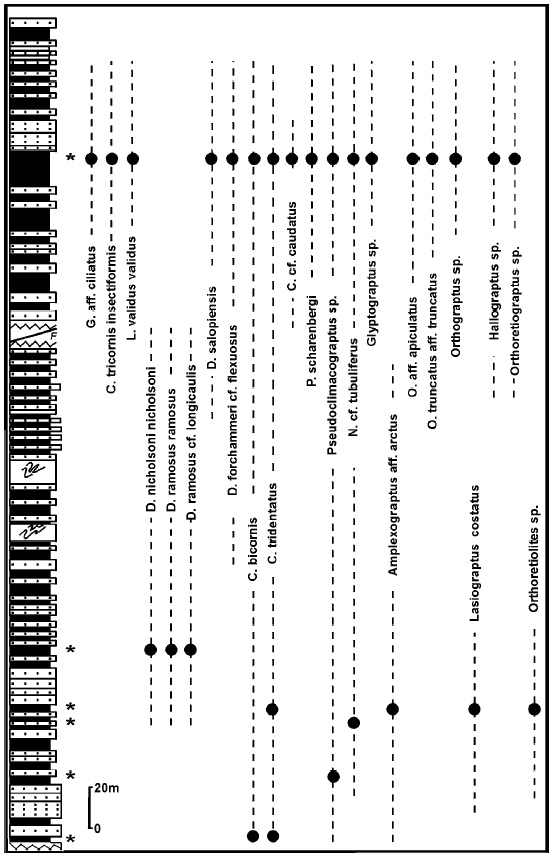
Figure 5. Correlation chart for units bearing C. bicornis Biozone in central and western Precordillera.
finally concentrated. In the Pavón Formation samples zircon is the most abundant heavy mineral; it is also the major host of Zr and Hf and it is enriched in HREE. The distribution of these elements should reflect zircon abundance. In Figure 7 typical aspects of Pavón Formation thin sections are shown, as the matrix content, sorting, grain size and roundness. Some principal components are also shown, as a non altered albite twinned plagioclase and low and high grade metamorphic rock fragments (Fig. 7a,b). Two zircons were selected as examples of morphology variations may be due to different source rocks (Fig. 7c,d); equidimensional individuals could have a magmatic origin, but elongated ones could be from a volcanic source.
Zircon crystallizes in most plutonic rocks, in intermediate to differentiated lavas and could also recrystallized in high-grade metamorphic rocks. Their primary characteristics are preserved in sedimentary and low grade metamorphic rocks, and their morphology distribution is not affected by grain size variations. The physical and chemical conditions under which zircon crystallizes control the relative development of prism faces as well as pyramid faces. Several polished thin sections of the Pavón Formation were analyzed on a scanning electron microscope using also energy dispersive spectrometry (SEM-EDS), at the Centralized Analytical Facility, Rand Afrikaans University, South Africa. In SEM-EDS microphotographs is possible to distinguish from rounded to euhedral zircons.
Roundness normally is used as an indicator of extensive transport or reworking, but well rounded zircons could form through in situ growth of a metamorphic rim around an originally euhedral grain (Hanchar and Miller, 1993).
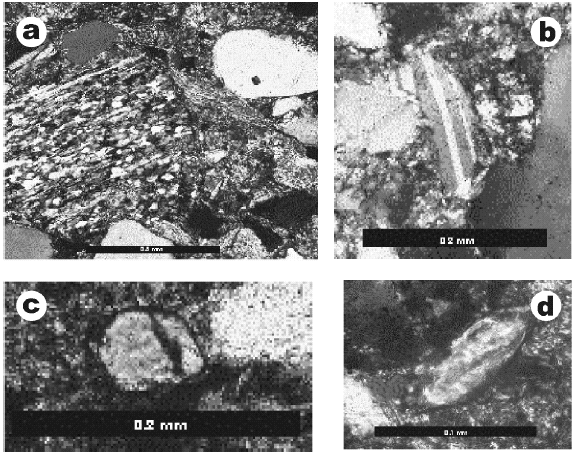
Fig. 7:
Microphotographs of Pavón Formation thin sections. All of them under crossed nicols. a: metamorphic fragment; b: albite twinned plagioclase grain; c,d: zircon grains.Final remarks
1) The stratigraphic age of the 700 m thick of the Pavón Formation is Lower Caradoc (
Climacograptus bicornis Biozone).2) The texture and composition of the Pavón Formation sandstones show 15 to 30% of matrix content, poor to moderate sorting and medium to very fine grain sizes. They are classified as quartz-feldspathic wackes.
3) The QFL provenance data, grouping in the recycled orogen and continental block, indicate that the source of detritus of the Pavón Formation had an average upper crustal composition.
4) The unit presents moderated Th/Sc and elevated Zr/Sc ratios reflecting significant reworking and a clear input from upper crust igneous sources (silicic and intermediate magmatic precursors).
5) Trace elements diagrams depict an active margin and island continental arc provenance for the Pavón Formation samples.
6) REE elements distribution give evidence of strong association between the Pavón Formation and upper crustal source material. In sedimentary sorting and recicling aspects, the samples show that the zircon is the most abundant heavy mineral; it is also the major host of Zr and Hf and it is enriched in HREE. The distribution of these elements should reflect zircon abundance.
7) In the regional context of the evolution of the Precordillera terrane, the data support the model that the Pavón Formation was deposited in a basin generated after the accretion of the Precordillera terrane at the actual position in Gondwana margin, and uplift by thrusting of the Grenville-age crust to the East, as a possible source for sediments.
Acknowledgements.
Special thanks to Dr. Udo Zimmermann for his valuable comments and suggestions. To CONICET for financial support. The Centro de Investigaciones Geológicas, La Plata- Argentina and the Rand Afrikáans University, South Africa, were utilized for important laboratory work. This is a contribution to IGCP 436.References
Aceñolaza, F.G., Miller, H. and Toselli, A., 2002. Proterozoic-Early Paleozoic evolution in western South Americaa discusión.
Tectonophysics 354:121-137.Astini, R.A., Benedetto, J.L. and Vaccari, N.E., 1995. The early Paleozoic evolution of the Argentine Precordillera as a Laurentian rifted, drifted, and collided terrane: A geodynamic model.
Geol. Soc. Am. Bull., 107, 253-273.Bahlburg, H., 1998. The Geochemistry and Provenance of Ordovician Turbidites in the Argentine Puna In: Pankhurst R.J. and Rapela, C.W., (Eds) The Protoandean Margin of Gondwana,
Geological Society, London, Special Publication 142, 127-142.Bhatia, M. R. and Crook, K. A. W., 1986. Trace Element Characteristics of Graywackes and Tectonic Setting Discrimination of Sedimentary Basins.
Contributions to Mineralogy and Petrology 92: 181-193.Bock, B., Bahlburg, H., Wörner, G. and Zimmermann, U. 2000. Tracing Crustal Evolution in the Southern Central Andes from Late Precambrian to Permian with Geochemical and Nd and Pb isotope Data.
The Journal of Geology, 108:515-535.Cingolani, C.A., Cuerda, A. and Manassero, M., 1999. Litoestratigrafía de los depósitos silicoclásticos ordovícicos del Cerro Bola, Bloque de San Rafael, Mendoza.
XIV Congreso Geológico Argentino, Actas 1:409-413. Salta.Cingolani, C.A., Manassero, M., Abre, P. 2002. Geoquímica de elementos traza y tierras raras de las sedimentitas de la Formación Pavón, Ordovícico del Bloque de San Rafael, Mendoza.
XV Congreso Geológico Argentino, CD-Rom versión.Cuerda, A.J. and Cingolani, C.A., 1998. El Ordovícico de la región del Cerro Bola en el Bloque de San Rafael, Mendoza: sus faunas graptolíticas.
Ameghiniana 35(4):427-448.Dalla Salda, L.H., Cingolani, C.A. and Varela, R., 1992. Early Paleozoic belt of the Andes and Southwestern South America: result of Laurentia-Gondwana collision?.
Geology, 20, 517-520.Dessanti, R.N., 1956. Descripción geológica de la Hoja 27 c-Cerro Diamante (Provincia de Mendoza).
Dirección Nacional de Geología y Minería, Boletin 85:1-79. Buenos Aires.Dickinson, W.R. and Suczek, C., 1979. Plate tectonics and sandstone composition.
American Association of Petroleum Geologists, Bulletin, 63: 2164-2192.Dickinson, W.R., Beard, S., Brakenbridge, F., Erjavec, J., Ferguson, R., Inman, K., Knepp, R., Lindberg, P. and Ryberg, P., 1983. Provenance of North American Phanerozoic sandstones in relation to tectonic setting.
Geological Society of America. Bulletin 64:233-235.Floyd, P.A, and Winchester, J.A., 1975. Magma type and tectonic setting discrimination using immobile elements.
Earth and Planetary Science Letters, 27:211-218.Floyd, P.A. and Leveridge, B.E., 1987. Tectonic environment of the Devonian Gramscatho basin, south Cornwall: framework mode and geochemical evidence from turbiditic sandstones.
Journal of the Geological Society, London, 144, 531-542.González Díaz, E.F., 1981. Nuevos argumentos a favor del desdoblamiento de la denominada "Serie de la Horqueta" del Bloque de San Rafael.Provincia de Mendoza.
8° Congreso Geológico Argentino. Actas 3:241-256. San Luis.Hanchar, J. M. and Miller, C. F., 1993. Zircon zonation patterns as revealed by cathodoluminescence and backscattered electron images: Implications for interpreting complex crustal histories.
Chemical Geology 110, 1-13.Holmberg, E., 1948. Geología del Cerro Bola. Contribución al conocimiento de la tectónica de la Sierra Pintada. Secretaría de Industria y Comercio de la Nación.
Dirección General de Industria y Minería. Boletín 69:313-361. Buenos Aires.Keller, M., 1999. The Argentine Precordillera – sedimentary and plate tectonic history of a Laurentian crustal fragment in south America.
Geol. Soc. Spec. Publ. 341, p 1-239.Loske, W., 1992. Sedimentologie, Herkunft und geotektonische Entwicklung paläzoischer Gesteine der Präkordillere West-Argentiniens.
Münch. Geol. Hefte, 7, 155 pp.Manassero, M., Cingolani, C. A., Cuerda, A. J., Abre,P., 1999. Sedimentología, Paleoambiente y Procedencia de la Formación Pavón (Ordovícico) del Bloque de San Rafael, Mendoza.
Revista de la Asociación Argentina de Sedimentología 6 (1-2):75-90.McLennan, S.M., 1989. Rare Earth Elements in Sedimentary Rocks: Influence of Provenance and Sedimentary Process. In: Geochemistry and Mineralogy of Rare Earth Elements
. (Ed. by B. R. Lipin and G. A. McKay), Mineralogical Society of America, Reviews in Mineralogy, 21: 169-200.McLennan, S. M., Taylor, S. R., 1991. Sedimentary rocks and crustal evolution: tectonic setting and secular trends.
Journal of Geology, vol. 99: 1-21.McLennan, S. M., Hemming, S., McDaniel, D. K. and Hanson, G. N., 1993. Geochemical approaches to sedimentation, provenance and tectonics. In: Processes controlling the composition of clastic sediments. (Ed. by Johnsson, M. J. & Basu, A.)
Geological Society of America, Special Papers, 285:21-40.Núñez, E., 1979. Descripción geológica de la Hoja 28d. Estación Soitué, Provincia de Mendoza.
Servicio Geológico Nacional. Boletín 166:1-67. Buenos Aires.Pankhurst, R. J. and Rapela, C. W., 1998. The proto-Andean margin of Gondwana: an introduction. In: Pankhurst, R. J. & Rapela, C. W., (eds) The Proto-Andean Margin of Gondwana.
Geological Society, London, Special Publications,142, 127-142.Ramos, V.A., Mpodozis, C., Kay, S., Cortés, J.M. and Palma, M.A. 1986. Paleozoic terranes of the Central Argentine- Chilean Andes.
Tectonics, 5:855-880.Ramos, V.A., Dallmeyer, R. and Vujovich, G. (1998) Time constraints on the Early Paleozoic docking of the Precordillera, central Argentina. In: The Proto-Andean Margin of Gondwana (Eds R.J. Pankhurst and C.W. Rapela)
Geological Society, London, Special Publications, 142, 143-158.Ramos, V.A., 1999. Rasgos estructurales del territorio argentino. I. Evolución tectónica de la Argentina.
In Geología Argentina. Anales 29 (24):715-784. Buenos Aires.Sato, A.M., Tickyj, H., Llambías, E.J. and Sato, K. 2000. The Las Matras tonalitic-trondhjemitic pluton, central Argentina: Grenvillian-age constraints, geochemical characteristics, and regional implications.
Journal of South America Earth Sciences 13:587-610.Taylor, S. R. and McLennan, S. M., 1985.
The Continental Crust. Its Composition and Evolution. Blackwell, London, 312 pp.Winchester, J. A. and Floyd, P. A., 1977. Geochemical discrimination of different magma series and the differentiation products using immobile elements.
Chem. Geol. 20: 325-343.Zimmermann, U., 2000. The evolution of the Ordovician southern Puna-Basin in NW Argentina – a compilation.
IX Congreso Geológico Chileno; Actas 1: 720-725. Puerto Varas.Recibido
: 15 de Agosto de 2002Aceptado
: 18 de Noviembre de 2002